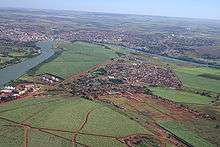Economy of Brazil
|
The Itaim Bibi Financial District, São Paulo, Brazil | |
| Currency | Brazilian real (BRL, R$) |
|---|---|
| Calendar year | |
Trade organisations | Unasul, WTO, Mercosur, G-20 and others |
| Statistics | |
| GDP |
$2.0 trillion (Nominal) (2017 est.) [1] $3.2 trillion (PPP) (2017 est.) [1] |
| GDP rank | 9th (nominal, 2016) / 7th (PPP, 2016) |
GDP growth |
0.1% (2014), -3.8% (2015), -4.0% (2016f), -0.2% (2017)[2] |
GDP per capita |
$10,000 (2015 est.) (nominal; 69th)[1] |
GDP by sector |
services: 76% industry: 18.5% agriculture: 5.5% (2016 est.)[3] |
|
| |
Population below poverty line |
|
|
| |
Labour force | 109 million (2015 est.) |
Labour force by occupation |
services: 71% agriculture: 15.7% industry: 13.3% (2011 est.) |
| Unemployment |
|
|
| |
| External | |
| Exports |
|
Export goods | transport equipment, iron ore, soybeans, footwear, coffee, automobiles |
Main export partners |
|
| Imports |
|
Import goods | machinery, electrical and transport equipment, chemical products, oil, automotive parts, electronics |
Main import partners |
|
Gross external debt | $0.71 trillion (31 December 2014 est.) |
| Public finances | |
|
| |
| Revenues | $0.63 trillion (2015 est.) |
| Expenses | $0.64 trillion (2015 est.) |
|
Standard & Poor's:[12] Fitch:[13] Ba2 Outlook: Negative | |
Foreign reserves | $0.36 trillion (December 2015) |
Brazil has the world's ninth largest economy by nominal GDP, and the fifth largest by purchasing power parity. The Brazilian economy is characterized by moderately free markets and an inward-oriented economy.
Brazil's economy is the largest of Latin America and the second largest in the Americas.[15] From 2000 to 2012, Brazil was one of the fastest-growing major economies in the world, with an average annual GDP growth rate of over 5%, with its economy in 2012 surpassing that of the United Kingdom, temporarily making Brazil the world's sixth largest economy. However, Brazil's economy growth decelerated in 2013[16] and the country entered an ongoing recession in 2014.
According to the World Economic Forum, Brazil was the top country in upward evolution of competitiveness in 2009, gaining eight positions among other countries, overcoming Russia for the first time, and partially closing the competitiveness gap with India and China among the BRIC economies. Important steps taken since the 1990s toward fiscal sustainability, as well as measures taken to liberalize and open the economy, have significantly boosted the country's competitiveness fundamentals, providing a better environment for private-sector development.[17]
In 2012 Forbes ranked Brazil as having the 5th largest number of billionaires in the world, a number much larger than what is found in other Latin American countries, and even ahead of United Kingdom and Japan.[18] Brazil is a member of diverse economic organizations, such as Mercosur, Unasul, G8+5, G20, WTO, and the Cairns Group.
History
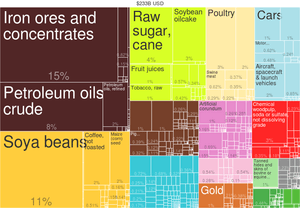
When the Portuguese explorers arrived in the 16th century, the native tribes of current-day Brazil, totaling about 2.5 million people, had lived virtually unchanged since the Stone Age. From Portugal's colonization of Brazil (1500–1822) until the late 1930s, the market elements of the Brazilian economy relied on the production of primary products for exports. Within the Portuguese Empire, Brazil was a colony subjected to an imperial mercantile policy, which had three main large-scale economic production cycles – sugar, gold and from the early 19th century on, coffee. The economy of Brazil was heavily dependent on African enslaved labour until the late 19th century (about 3 million imported African enslaved individuals in total). In that period Brazil was also the colony with the largest amount of European settlers, most of them being Portuguese (including Azoreans and Madeirans) but also some Dutch (see Dutch Brazil), Spaniards, English, French, Germans, Flemish, Danish, Scottish and sephardic Jews. Since then, Brazil experienced a period of strong economic and demographic growth accompanied by mass immigration from Europe, mainly from Portugal (including the Azores and Madeira), Italy, Spain, Germany, Poland, Ukraine, Switzerland, Austria and Russia. Smaller amounts of immigrants also came from the Netherlands, France, Finland, Iceland and the Scandinavian countries, Lithuania, Belgium, Bulgaria, Hungary, Greece, Latvia, England, Ireland, Scotland, Croatia, Czech Republic, Malta, Macedonia and Luxembourg), the Middle East (mainly from Lebanon, Syria and Armenia), Japan, the United States and South Africa, until the 1930s. In the New World, the United States, Argentina, Brazil, Canada, Australia, Uruguay, New Zealand, Chile, Mexico, Cuba, Venezuela, Paraguay, Puerto Rico and Peru (in descending order) were the countries that received most immigrants. In Brazil's case, statistics show that 4.5 million people emigrated to the country between 1882 and 1934.

Currently, with a population of over 204 million and abundant natural resources, Brazil is one of the ten largest markets in the world, producing tens of millions of tons of steel, 26 million tons of cement, 3.5 million television sets, and 3 million refrigerators. In addition, about 70 million cubic meters of petroleum were being processed annually into fuels, lubricants, propane gas, and a wide range of hundred petrochemicals. Furthermore, Brazil has at least 161,500 kilometers of paved roads and more than 93 Gigawatts of installed electric power capacity.
Its real per capita GDP has surpassed US$10,500 in 2008, due to the strong and continued appreciation of the real for the first time this decade. Its industrial sector accounts for three-fifths of the Latin American economy's industrial production.[19] The country's scientific and technological development is argued to be attractive to foreign direct investment, which has averaged US$30 billion per year the last years, compared to only US$2 billion per year last decade,[19] thus showing a remarkable growth. The agricultural sector, locally called the agronegócio (agrobusiness), has also been remarkably dynamic: for two decades this sector has kept Brazil amongst the most highly productive countries in areas related to the rural sector.[19] The agricultural sector and the mining sector also supported trade surpluses which allowed for massive currency gains (rebound) and external debt paydown. Due to a downturn in Western economies, Brazil found itself in 2010 trying to halt the appreciation of the real.[20]
Data from the Asian Development Bank and the Tax Justice Network show the untaxed "shadow" economy of GDP for Brazil is 39%.[21]
Components
The service sector is the largest component of GDP at 67.0 percent, followed by the industrial sector at 27.5 percent. Agriculture represents 5.5 percent of GDP (2011).[22] Brazilian labor force is estimated at 100.77 million of which 10 percent is occupied in agriculture, 19 percent in the industry sector and 71 percent in the service sector.
Agriculture and food production
| Agriculture production | ||
|---|---|---|
| | ||
| Combine harvester on a plantation | ||
| Main products | coffee, soybeans, wheat, rice, corn, sugarcane, cocoa, citrus; beef | |
| Labor force | 15.7% of total labor force | |
| GDP of sector | 5.9% of total GDP | |
Agribusiness contributes to Brazil's trade balance, in spite of trade barriers and subsidizing policies adopted by the developed countries.[23]
In the space of fifty five years (1950 to 2005), the population of Brazil grew from 51 million to approximately 187 million inhabitants,[24] an increase of over 2 percent per year. Brazil created and expanded a complex agribusiness sector.[23] However, some of this is at the expense of the environment, including the Amazon.
The importance given to the rural producer takes place in the shape of the agricultural and cattle-raising plan and through another specific subsidy program geared towards family agriculture (Pronaf), which guarantee financing for equipment and cultivation and encourage the use of new technology. With regards to family agriculture, over 800 thousand rural inhabitants are assisted by credit, research and extension programs. A special line of credit is available for women and young farmers.[23]
With The Land Reform Program, on the other hand, the country's objective is to provide suitable living and working conditions for over one million families who live in areas allotted by the State, an initiative capable of generating two million jobs. Through partnerships, public policies and international partnerships, the government is working towards the guarantee of an infrastructure for the settlements, following the examples of schools and health outlets. The idea is that access to land represents just the first step towards the implementation of a quality land reform program.[23]
Over 600,000 km² of land are divided into approximately five thousand areas of rural property; an agricultural area currently with three borders: the Central-western region (savanna), the northern region (area of transition) and parts of the northeastern region (semi-arid). At the forefront of grain crops, which produce over 110 million tonnes/year, is the soybean, yielding 50 million tonnes.[23]
In the cattle-raising sector, the "green ox," which is raised in pastures, on a diet of hay and mineral salts, conquered markets in Asia, Europe and the Americas, particularly after the "mad cow disease" scare period. Brazil has the largest cattle herd in the world, with 198 million heads,[25] responsible for exports surpassing the mark of US$1 billion/year.[23]
A pioneer and leader in the manufacture of short-fiber timber cellulose, Brazil has also achieved positive results within the packaging sector, in which it is the fifth largest world producer. In the foreign markets, it answers for 25 percent of global exports of raw cane and refined sugar; it is the world leader in soybean exports and is responsible for 80 percent of the planet's orange juice, and since 2003, has had the highest sales figures for beef and chicken, among the countries that deal in this sector.[23]
Industry
| Industrial production | ||
|---|---|---|
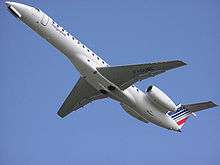 | ||
| Embraer RJ 145 jet manufactured by Embraer | ||
| Main industries | textiles, shoes, chemicals, cement, lumber, iron ore, tin, steel, aircraft, motor vehicles and parts, other machinery and equipment | |
| Industrial growth rate | −5% (2015 est.) | |
| Labor force | 13.3% of total labor force | |
| GDP of sector | 22.2% of total GDP | |
Brazil has the third-largest manufacturing sector in the Americas. Accounting for 28.5 percent of GDP, Brazil's industries range from automobiles, steel and petrochemicals to computers, aircraft, and consumer durables. With increased economic stability provided by the Plano Real, Brazilian and multinational businesses have invested heavily in new equipment and technology, a large proportion of which has been purchased from US firms.
Brazil has a diverse and sophisticated services industry as well. During the early 1990s, the banking sector accounted for as much as 16 percent of the GDP. Although undergoing a major overhaul, Brazil's financial services industry provides local businesses with a wide range of products and is attracting numerous new entrants, including U.S. financial firms. On 8 May 2008, the São Paulo Stock Exchange (Bovespa) and the São Paulo-based Brazilian Mercantile and Futures Exchange (BM&F) merged, creating BM&F Bovespa, one of the largest stock exchanges in the world. Also, the previously monopolistic reinsurance sector is being opened up to third party companies.[26]
As of 31 December 2007, there were an estimated 21,304,000 broadband lines in Brazil. Over 75 percent of the broadband lines were via DSL and 10 percent via cable modems.
Proven mineral resources are extensive. Large iron and manganese reserves are important sources of industrial raw materials and export earnings. Deposits of nickel, tin, chromite, uranium, bauxite, beryllium, copper, lead, tungsten, zinc, gold, and other minerals are exploited. High-quality coking-grade coal required in the steel industry is in short supply.
Largest companies
In 2011, 36 Brazilian companies were listed in the Forbes Global 2000 list – an annual ranking of the top 2000 public companies in the world by Forbes magazine.[27] The 13 leading companies were:
| World Rank | Company | Industry | Revenue (billion $) | Profits (billion $) | Assets (billion $) | Market Value (billion $) | Headquarters |
|---|---|---|---|---|---|---|---|
| 4 | Petrobras | Oil & Gas Operations | 138.80 | 21.26 | 313.25 | 238.80 | Rio de Janeiro |
| 20 | Vale | Mining | 46.54 | 18.12 | 132.86 | 184.96 | Rio de Janeiro |
| 51 | Itaú Unibanco | Banking | 71.47 | 8.37 | 507.84 | 115.08 | São Paulo |
| 64 | Ambev | Beverage | 15.90 | 4.75 | 54.92 | 86.45 | São Paulo |
| 80 | Banco Bradesco | Banking | 52.43 | 6.37 | 445.19 | 74.32 | Osasco, SP |
| 101 | Banco do Brasil | Banking | 48.97 | 7.00 | 546.91 | 54.89 | Brasilia |
| 203 | OGX | Oil & Gas Operations | 14.54 | 5.51 | 6.74 | 39.23 | Rio de Janeiro |
| 235 | Itaúsa | Conglomerates | 66.44 | 2.33 | 342.60 | 36.08 | São Paulo |
| 342 | CSN | Steel & Cement | 9.34 | 1.94 | 16.88 | 30.47 | Rio de Janeiro |
| 398 | Gerdau | Iron & Steel | 23.40 | 1.49 | 27.66 | 23.18 | Porto Alegre |
| 487 | Eletrobras | Utilities | 16.40 | 1.32 | 78.45 | 21.22 | Rio de Janeiro |
| 547 | Usiminas | Mining & Siderurgy | 7.95 | 1.02 | 18.95 | 19.33 | Belo Horizonte |
| 640 | Embraer | Aerospace & Defense | 6.14 | 1.03 | 15.69 | 17.56 | São José dos Campos, SP |
Energy
The Brazilian government has undertaken an ambitious program to reduce dependence on imported petroleum. Imports previously accounted for more than 70% of the country's oil needs but Brazil became self-sufficient in oil in 2006–2007. Brazil is one of the world's leading producers of hydroelectric power, with a current capacity of about 260,000 megawatts. Existing hydroelectric power provides 90 percent of the nation's electricity. Two large hydroelectric projects, the 19,900 megawatt Itaipu Dam on the Paraná River (the world's largest dam) and the Tucurui Dam in Pará in northern Brazil, are in operation. Brazil's first commercial nuclear reactor, Angra I, located near Rio de Janeiro, has been in operation for more than 10 years. Angra II was completed in 2002 and is in operation too. An Angra III has its planned inauguration scheduled for 2014. The three reactors would have combined capacity of 9,000 megawatts when completed. The government also plans to build 19 more nuclear plants by the year 2020.
Economic status
| Statistical Table | |
|---|---|
| Inflation (IPCA) | |
| 2002 | 12.53% |
| 2003 | 9.30% |
| 2004 | 7.60% |
| 2005 | 5.69% |
| 2006 | 3.14% |
| 2007 | 4.46% |
| 2008 | 5.91% |
| 2009 | 4.31% |
| 2010 | 5.90% |
| 2011 | 6.50% |
| 2012 | 5.84% |
| 2013 | 5.91% |
| 2014 | 6.41% |
| 2015 | 10.67% |
| 2016 | 7.27% |
| Source:[28] | |
| Average GDP growth rate 1950–2013 | |
| 1950–59 | 7.1% |
| 1960–69 | 6.1% |
| 1970–79 | 8.9% |
| 1980–89 | 3.0% |
| 1990–99 | 1.7% |
| 2000–09 | 3.3% |
| 2010–13 | 3.4% |
| Source:[29] | |
Sustainable growth
After the arrival of the Portuguese explorers in 1500, it was only in 1808 that Brazil obtained a permit from the Portuguese colonial government to set up its first factories and manufacturers. In the 21st century, Brazil reached the status of 8th largest economy in the world. Originally, the export list was basic raw and primary goods, such as sugar, rubber and gold. Today, 84 percent of exports consists of manufactured and semi-manufactured products.
The period of great economic transformation and growth occurred between 1875 and 1975.
In the last decade, domestic production increased by 32.3 percent and agribusiness (agriculture and cattle-raising), which grew by 47 percent or 3.6 percent per year, was the most dynamic sector – even after having weathered international crises that demanded constant adjustments to the Brazilian economy.[30] The Brazilian government also launched a program for economic development acceleration called Programa de Aceleração do Crescimento, aiming to spur growth.
Brazil's transparency ranking status in the international world is 75th according to Transparency International.[31]
Control and reform
Among measures recently adopted to balance the economy, Brazil carried out reforms to its social security (state and retirement pensions) and Tax systems. These changes brought with them a noteworthy addition: a Law of Fiscal Responsibility which controls public expenditure by the executive branches at federal, state and municipal levels. At the same time, investments were made towards administration efficiency and policies were created to encourage exports, industry and trade, thus creating "windows of opportunity" for local and international investors and producers.
With these alterations in place, Brazil has reduced its vulnerability: it doesn't import the oil it consumes; it has halved its domestic debt through exchange rate-linked certificates and has seen exports grow, on average, by 20% a year. The exchange rate does not put pressure on the industrial sector or inflation (at 4% a year), and does away with the possibility of a liquidity crisis. As a result, the country, after 12 years, has achieved a positive balance in the accounts which measure exports/imports, plus interest payments, services and overseas payment. Thus, respected economists say that the country won't be deeply affected by the current world economic crisis.[32]
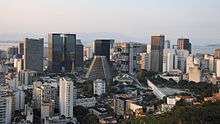
Consistent policies
Support for the productive sector has been simplified at all levels; active and independent, Congress and the Judiciary Branch carry out the evaluation of rules and regulations. Among the main measures taken to stimulate the economy are the reduction of up to 30 percent on manufactured products tax (IPI), and the investment of $8 billion on road cargo transportation fleets, thus improving distribution logistics. Further resources guarantee the propagation of business and information telecenters.
The policy for industry, technology and foreign trade, at the forefront of this sector, for its part, invests $19.5 billion in specific sectors, following the example of the software and semiconductor, pharmaceutical and medicine product, and capital goods sectors.[33]
Mergers and acquisitions

Between 1993 and 2010, 7.012 mergers & acquisitions with a total known value of US$707 billion with the involvement of Brazilian firms have been announced.[34] The year 2010 was a new record in terms of value with $115 billion of transactions. The largest transaction with involvement of Brazilian companies has been: Cia Vale do Rio Doce acquired Inco in a tender offer valued at $18.9 billion.
Entrepreneurship
According to a search of Global Entrepreneurship Monitor in 2011 Brazil had 27 million adults aged between 18 and 64 either starting or owning a business, meaning that more than one in four Brazilian adults were entrepreneurs. In comparison to the other 54 countries studied, Brazil was the third-highest in total number of entrepreneurs. Ipea, a government agency, found that 37 million jobs in Brazil were associated with businesses with up to 10 employees.[35]
Even though Brazil ranks internationally as one of the hardest countries in the region to do business due to its complicated bureaucracy. There is a healthy number of entrepreneurs, thanks to the huge market and the government programs.
The most recent research of Global Entrepreneurship Monitor revealed in 2013 that 50.4% of Brazilian new entrepreneurs are men, 33.8% are in the 35–44 age group, 36.9% completed high school and 47.9% earn 3–6 times the Brazilian minimum wage. In contrast, 49.6% of entrepreneurs are female, only 7% are in the 55–64 age group, 1% have postgraduate education and 1.7% earn more than 9 times the minimum wage.[36]
Credit rating
Brazil's credit rating was downgraded by Standard & Poor's to BBB in March 2014, just one notch above junk.[37]
Income

The minimum wage set for the year of 2014 is R$724 reais per month plus an additional 13th salary in second half of December.[40] The GDP per capita in 2011 was US$12,906.[41]
| Career[42] | Median salary (R$) | Starting salary (R$) | Top salary (R$) | |
|---|---|---|---|---|
| Judge | Law | 170,000 | 150,500 | 310,500 |
| Prosecutor | Law | 150,000 | 140,000 | 270,000 |
| General director | Administration | 90,000 | 60,000 | 1,450,000 |
| Physician | Medicine | 85,000 | 40,000 | 1,550,000 |
| Judicial analyst | Law | 80,000 | 70,000 | 90,000 |
| Police chief | Law | 60,000 | 50,000 | 85,000 |
| Electronic engineer | Engineering | 51,000 | 33,600 | 360,000 |
| Civil engineer | Engineering | 50,400 | 22,800 | 360,000 |
| Other engineers | Engineering | 45,000 | 24,000 | 130,000 |
| Economic researcher | Economy | 44,000 | 24,000 | 180,000 |
| Mechanical engineer | Engineering | 42,600 | 26,200 | 105,000 |
| Department supervisor | Administration | 41,964 | 20,076 | 420,000 |
| Taxation Officer | Government | 41,520 | 26,400 | 240,000 |
| Professors | Higher education | 40,440 | 20,000 | 300,000 |
| Agronomist | Agronomy | 40,000 | 27,600 | 96,000 |
| Chemical engineer | Engineering | 40,000 | 31,200 | 420,000 |
| Systems analyst | Computer science | 38,400 | 30,000 | 180,000 |
| Dentist | Dentistry | 37,800 | 29,400 | 720,000 |
| Architect | Architecture | 37,320 | 13,800 | 600,000 |
| Lawyer | Law | 36,120 | 20,040 | 3,000,000 |
| Accountant | Accountancy | 35,880 | 17,400 | 216,000 |
| Administrator | Administration | 35,400 | 25,080 | 1,800,000 |
| Journalist | Journalism | 32,880 | 18,000 | 2,400,000 |
See also
- Brazilian Packaging Market
- List of Brazilian federative units by gross domestic product
- Corruption in Brazil
References
- 1 2 3 4 "Report for Selected Countries and Subjects". World Economic Outlook Database, International Monetary Fund. April 2015. Retrieved 14 December 2015.
- ↑ "World Bank forecasts for Brazil, June 2016" (PDF). World Bank. Retrieved 27 September 2016.
- ↑ Table 3 - Cumulative Rate in the Year IBGE. Retrieved on 30 March 2016.
- ↑ "Inflation Brazil – current Brazilian inflation". Inflation.eu.
- ↑ Brazil – World Development Indicators
- ↑ "Desigualdade cai em 2014 com alta de renda dos mais pobres, diz IBGE". Folha de S. Paulo. Retrieved 25 April 2016.
- ↑ Brazil’s Unemployment Rises More Than All Forecasts in July Bloomberg. Retrieved on 20 August 2015.
- ↑ "Doing Business in Brazil 2015". World Bank. Retrieved 22 August 2015.
- 1 2 "Brazilian Trade Balance: Consolidated Data" (PDF). Ministério do Desenvolvimento, Indústria e Comércio Exterior. 2012. Retrieved 16 April 2012.
- ↑ "Export Partners of Brazil". CIA World Factbook. 2012. Retrieved 25 July 2013.
- ↑ "Import Partners of Brazil". CIA World Factbook. 2012. Retrieved 25 July 2013.
- ↑ DeFotis, Dimitra (17 February 2016). "Blame Oil: S&P Cuts Brazil & Saudi Ratings, Affirms Dire Russia Outlook". Barron's. Retrieved 17 March 2016.
- ↑ Pacheco, Felipe; Sambo, Paula. "Brazil Gets Second Junk Rating as Fitch Cites Economic Slump". Bloomberg Business. Retrieved 17 March 2016.
- ↑ "Moody's downgrades Brazil's issuer and bond ratings to Ba2 with a negative outlook". Moody's. Retrieved 17 March 2016.
- ↑ Is Brazil’s Economy Getting Too Hot? Forbes. Retrieved on 24 October 2011.
- ↑ http://america.aljazeera.com/articles/2015/8/17/despite-protests-wont-lead-to-radical-change-in-brazil.html
- ↑ Global Competitiveness Report 2009-2010 World Economic Forum. Retrieved on 24 October 2011.
- ↑ Kroll, Luisa (10 March 2010). "The World's Billionaires". Forbes.
- 1 2 3 About Brazil Brazilian government. Retrieved on 24 October 2011.
- ↑ Brazil's Currency Wars – A "Real" Problem Sounds and Colours. Retrieved on 24 October 2011.
- ↑ The Secret Strength of Pakistan's Economy – Businessweek
- ↑ http://www.worlddiplomacy.org/Countries/Brazil/InfoBra.html
- 1 2 3 4 5 6 7 Agriculture Brazilian Government. Retrieved on 24 October 2011.
- ↑ Popclock IBGE
- ↑ Indicators Brazilian Government. Retrieved on 24 October 2011.
- ↑ "Government breaks reinsurance monopoly, discards privatization (in Portuguese)". Retrieved 29 April 2008.
- ↑ "Forbes Global 2000: Brazil". 2 April 2008.
- ↑ Inflation Ipea
- ↑ Average Exchange Rate Ipea
- ↑ Sustainable growth Brazilian Government. Retrieved on 24 October 2011.
- ↑ Transparency by country 2009 Transparency International. Retrieved on 24 October 2011.
- ↑ Control and reform Brazilian Government. Retrieved on 24 October 2011.
- ↑ Consistent policies Brazilian government. Retrieved on 24 October 2011.
- ↑ Mergers and Acquisitions: Brazil Institute of Mergers, Acquisitions and Alliances. Retrieved on 24 October 2011.
- ↑ http://web.grupomaquina.com/maquinaNet/techEngine?sid=MaquinaNet&command=noticiaClippingSite&action=visualizar&idNoticia=2368106366895 A spirit for entreprise, Finantial Times Online, May 8th,2013
- ↑ http://www.gemconsortium.org/docs/2645/gem-2012-global-report GEM 2012 Global Report
- ↑ Rousseff Losing Bond Investors as Downgrade to Junk Looms – Bloomberg Bloomberg
- ↑ Median income – Brazilian Supreme Court Folha de S.Paulo. Retrieved on 24 October 2011. (Portuguese).
- ↑ GDP per capita – Brazilian cities in 2006 Brazilian Institute of Geography and Statistics. Retrieved on 24 October 2011. (Portuguese).
- ↑ 2014 Minimum Wage – Brazil (Portuguese) UOL. Retrieved on 2013. (Portuguese).
- ↑ Report for Selected Countries and Subjects: Brazil International Monetary Fund. Retrieved on 24 October 2011.
- ↑ Median Incomes in Brazil by Career in 2007 (FGV) Veja. Retrieved on 24 October 2011. (Portuguese).
External links
- São Paulo Stock Exchange Official website
- Central Bank of Brazil Official website
- "The Informality Trap: Tax Evasion, Finance, and Productivity in Brazil" World Bank Public Policy Journal
- Macroeconomic Policy, Growth and Income Distribution in the Brazilian Economy in the 2000s Center for Economic and Policy Research
- Comprehensive current and historial economic data
- World Bank Trade Summary Statistics Brazil 2012
- Information about Brazilian banks in English
- Tariffs applied by Brazil as provided by ITC's Market Access Map, an online database of customs tariffs and market requirements.
- Brazilian Soda Market
- International Trade Statistics – Brazil (2014)
Further reading
- Economic history of Brazil, author Caio Prado Junior
- Economic formation of Brazil, author Celso Furtado
- Baer, Werner. The Brazilian Economy: Growth and Development. 5th. Westport, CT: Praeger Publishers, 2001
- Center for Economic and Policy Research, The Brazilian Economy in Transition: Macroeconomic Policy, Labor and Inequality. (http://www.cepr.net/index.php/publications/reports/brazil-2014-09 ) September 2014
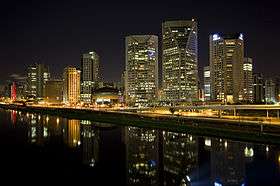
.jpg)
